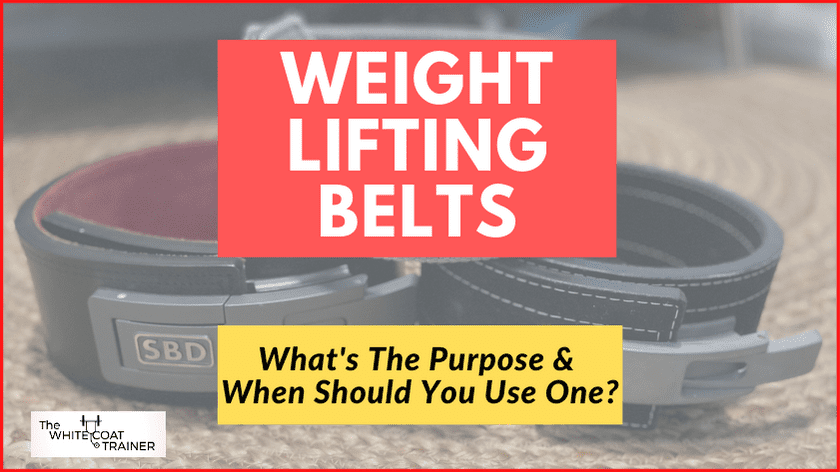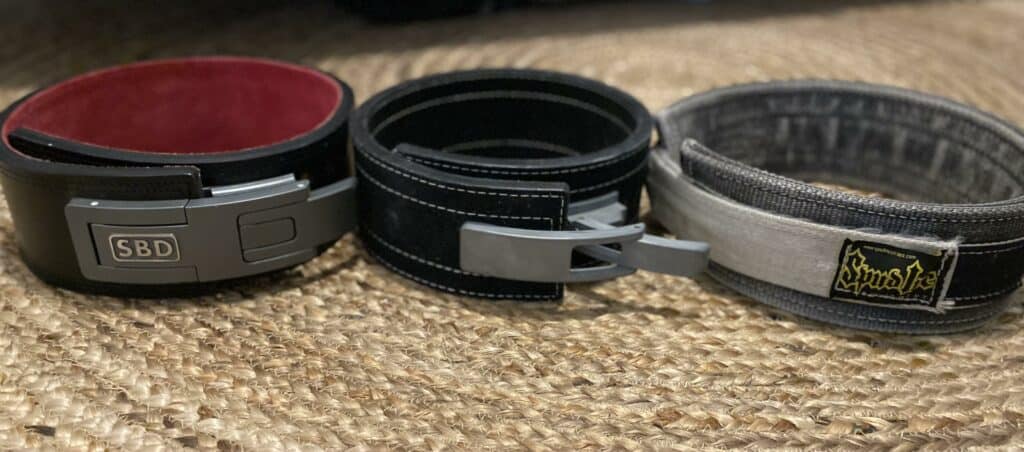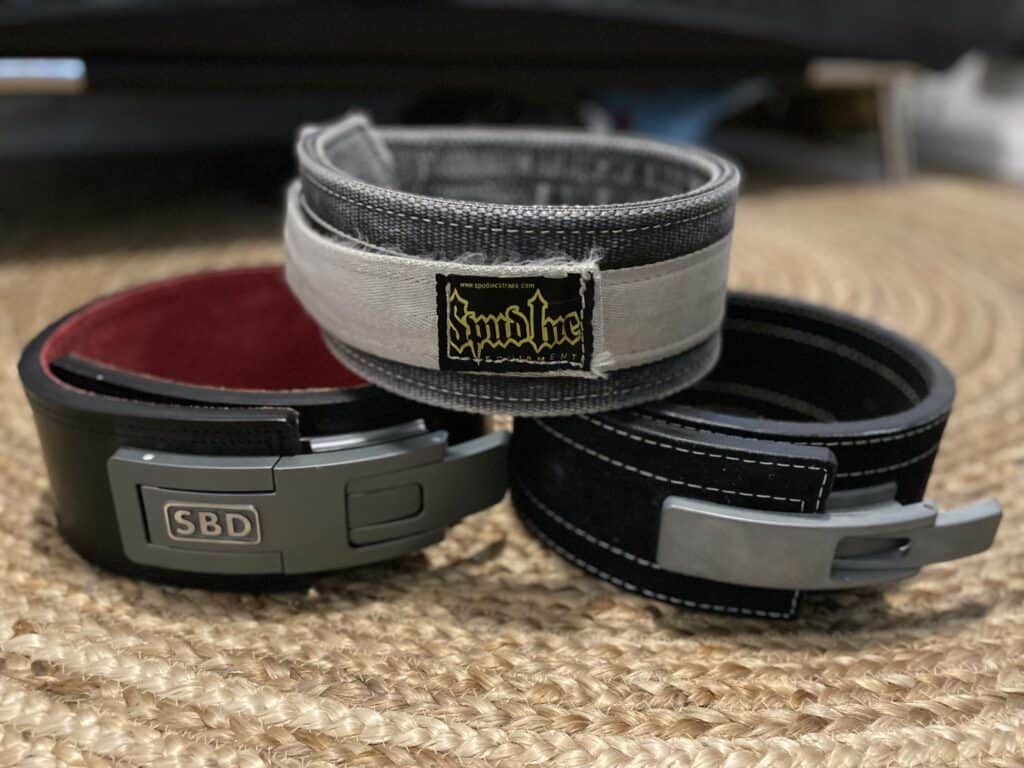Weightlifting belts are one of the most popular accessories in the gym.
But what is their purpose, and should you use one?
In this guide, you will learn:
- if a weight lifting belt is necessary for you,
- when to use one, and
- the different types of belts on the market.
Let’s get started.

Do You Need A Weightlifting Belt?
You might benefit from a weightlifting belt if you:
- regularly lift more than 1 to 1.5 times your body weight on squats and deadlifts
- want additional lower back support during heavy barbell exercises
- want to build above average strength and muscle
Keep reading to learn more.
What Does a Weightlifting Belt Do?
A weightlifting belt (or powerlifting belt) serves three primary purposes.
- It provides support to reduce stress on your lower back during heavy lifts
- It teaches you how to maintain constant intra-abdominal pressure when doing exercises that require core engagement
- It can improve your form on exercises that require a neutral spine
When worn correctly, the belt wraps around the entire core, which includes the rectus muscles, the obliques, and the spinal erectors (lower back).
This belt placement will allow you to expand your abdominal wall, similar to a balloon, when doing a heavy lift.
Weightlifting belts offer something for the core muscles to brace against, providing extra support and stability.
Who Should Use Them?
Weightlifting belts should be used by anyone who regularly lifts heavy weight, such as weightlifters, powerlifters, Olympic weightlifters, CrossFitters, or anyone simply looking to lift heavier.
Either way, athletes aren’t the only people who can benefit from the use of a belt. I recommend that everyone engage in strength training to improve overall health and wellbeing.
What Exercises are Weightlifting Belts Used for?
Weightlifting belts are helpful for various exercises, particularly ones involving the use of heavy barbells.
The most common examples include:
- deadlifts
- squats,
- barbell rows,
- sometimes bench presses and overhead presses and
- Olympic lifting (clean & jerk and snatch)
In general, most people can lift more weight using a belt than without one.
As such, belts help people feel more comfortable going heavy to achieve a higher one-rep max (1RMs) or new personal bests.
Should a Beginner Wear a Weightlifting Belt?
If you are a beginner, weight lifting belts are not necessary.
As a general rule of thumb, you likely won’t need a belt until you can lift at least 1 to 1.5x your bodyweight on squats and deadlifts.
For example, if you weigh 150 lbs – you will not need a belt until you squat and deadlift 150 lbs for repetitions.
Also, it is essential that you know how to lift with proper form before using a belt to lift heavier amounts.
Weightlifting belts won’t fix bad form. If your lifting technique is not great, attempting a heavy lift, even with a belt, can quickly lead to injury.
When shouldn’t You use a weightlifting belt?
There are three situations in which you should not wear a belt.
- If you have a weak core: Over-reliance on a belt might prevent core strength development and lead to weakness in your abdominal muscles over time.
- You are trying to hide or mask bad form and lower back pain: Always make sure that you are using proper form when doing a major barbell compound exercise.
- It restricts your breathing and mobility: Mobility restriction in exercises like the back squat can increase your risk of injury.
Also, you shouldn’t use a belt if your doctor has advised you to avoid doing the Valsalva maneuver (such as for those with high blood pressure or an increased risk of stroke).
The Valsalva maneuver is a breathing technique in which you breathe out through a closed glottis, brace your core, and bear down.
The Different Types of Lifting Belts
There are two main types of weightlifting or powerlifting belts:
- Prong belts and
- Lever belts.
A prong belt is similar to how a regular buckle belt looks. You place one or two prongs through pre-designed holes to adjust and tighten the belt to fasten it.
Lever belts use a more modern mechanism to tighten and loosen the belt. In general, they are easier to take on and off but are more challenging to adjust the level of tightness.
Both prong and lever belts offer similar levels of spinal support and intra abdominal pressure bracing.

The one you choose comes down to personal preference.
Good-quality weightlifting or powerlifting belts are made of leather, have a uniform width all the way around, and come in various thicknesses.
Other Belts
There is another type of belt known as a bodybuilding belt.
These are made of nylon, wider at the back than at the front, and fastened using a velcro strap.
These nylon velcro belts are less durable and provide only modest levels of abdominal support.
Lastly, you might hear about a dip belt.
Dip belts are not in the same category as weightlifting belts. These primarily serve to add external resistance to bodyweight exercises like dips and pull-ups.
How to wear a weightlifting belt
Here is the proper way of wearing a lifting belt:
- Place the belt around your waist at the level of your belly button
- Tighten the belt to the point where it is slightly uncomfortable
- Once the belt is tight, make sure that you can still expand your abdomen against it. If you can’t, loosen it a bit.
- Lastly, check if you feel any pinching or pain. If so, play around with the torso positioning of the belt.
Other Related Questions
Is it better to lift without a belt?
Training without a belt can increase your natural core strength and ability to create and maintain intra-abdominal pressure.
You should use a weightlifting belt only when you need to use it, i.e., when lifting a heavy load.
Do not use a belt during your warm-up sets or during exercises that aren’t overly demanding.
Is a weight belt cheating?
If you are a purist, you might consider a belt cheating. A weightlifting belt allows you to lift more weight and get stronger faster than if you don’t use one.
However, belts are not illegal in any professional sporting competitions.
If you are interested in getting stronger and lifting heavy, you should consider using a belt.
How tight should The belt be?
The belt should be tight enough that you are slightly uncomfortable but not so tight that you can’t expand your abdomen against it.
After fastening the belt, try and take a deep breath. Are you able to feel your belly, obliques, and lower back expanding against the belt?
If not, the belt is too tight.
At what weight should you use a belt?
You can consider wearing a belt once you can squat and deadlift between 1 and 1.5 times your body weight, and you are using loads that are 80% or more of your current one rep max.
Should I wear a belt while benching?
The primary benefit of wearing a belt during the bench press is to remember to keep your core muscles braced and engaged.
However, it is not necessary.
Unlike squats and deadlifts, a belt likely won’t increase the amount of weight you can lift on the bench.
You might also find it uncomfortable to wear a belt during the bench press.
TLDR – The Pros and Cons Of Weightlifting Belts
The advantages of weightlifting belts include:
- Provides spine and core support during heavy weightlifting
- Allows you to lift heavier weights on certain exercises
- Easy to use
- Available in different sizes, materials, and designs
Despite the pros, weightlifting belts do present some cons. Here are the disadvantages of belts:
- May weaken the lower back and spine over time
- Can hide or encourage bad form
- Can mask injuries (make you unaware of a potential injury)
- Can restrict breathing if worn too tight
So, are weightlifting belts necessary?
You will probably find a weightlifting belt beneficial if you perform heavy deadlifts, squats, clean + jerks, and snatches.
Similarly, if you lift competitively (powerlifting, Olympic weightlifting, strongman, or Crossfit), wearing a weightlifting belt can help you to improve your performance, lift heavier, and achieve new personal records (PRs).
However, if you are a beginner, a belt is not necessary until you have learned proper form and achieved moderate levels of strength (1- 1.5x your bodyweight on the major compound exercises).
The best weightlifting belts
The absolute best leather belt on the market is the SBD belt.
This premium belt combines the easy adjustability of a prong belt with the easy application of a lever belt.
However, it is pricey.
The SBD belt costs approximately 250 US.
If this belt is out of your price range, you can get one from an Inzer, one of the USA’s most reputable leather belt companies.
Inzer Forever belts come with a lifetime guarantee.
My recommendations are:
These belts usually cost ~120-140 US.

Lastly, if you prefer comfort and want an easily adjustable belt, the nylon Spud Inc deadlift belt is one of my favorites.
It is by far the most comfortable belt I have ever used.
The major downside of nylon belts is that it doesn’t provide as much support as leather belts.
Here is the Spud Inc Nylon belt, which is usually ~80.
What Do You Think?
Now I want to hear from you.
Do you regularly use a belt?
How much heavy lifting do you typically do?
Comment below and let me know.
Other Related Posts:
- How to Begin Strength Training Workouts For Busy People
- How Strong Should You Be? Realistic Strength Standards For Busy People
- The Best Compound Exercises For Your Entire Body

Alex Robles, MD, CPT / Brittany Robles, MD, MPH, CPT
Alex & Brittany Robles are physicians, NASM Certified Personal Trainers, and founders of The White Coat Trainer: a resource dedicated to improving the health and fitness of busy professionals using time-efficient strategies. Their advice has been featured in My Fitness Pal, Prevention, Livestrong, Reader’s Digest, Bustle, The Active Times, and more. Learn more about them here.
References:
- Lander JE, Hundley JR, Simonton RL. The effectiveness of weight-belts during multiple repetitions of the squat exercise. Med Sci Sports Exerc. 1992;24(5):603-609.
- Zink AJ, Whiting WC, Vincent WJ, McLaine AJ. The effects of a weight belt on trunk and leg muscle activity and joint kinematics during the squat exercise. J Strength Cond Res. 2001;15(2):235-240.
- Harman EA, Rosenstein RM, Frykman PN, Nigro GA. Effects of a belt on intra-abdominal pressure during weight lifting. Med Sci Sports Exerc. 1989;21(2):186-190.
